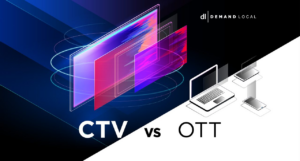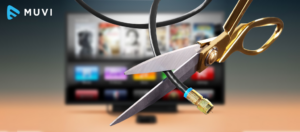The rise of streaming TV services is empowering a growing segment of consumers known as “cord cutters” – people cancelling traditional cable or satellite television in favour of internet-based alternatives.
This guide will explore what defines cord-cutters, the factors fueling this shift, and the implications for the future of home entertainment.

Defining Cord Cutters
Cord cutters refer to consumers who decide to terminate their subscriptions to traditional pay-TV services from cable, fiber, or satellite providers. Instead, they shift to using streaming over-the-top (OTT) services as their primary source of home television programming.
There are two main types of cord cutters:
- Partial cord-cutters – Maintain basic cable packages but supplement heavily with major OTT options like Netflix and Hulu for the majority of watching.
- Full cord-cutters – Eliminate pay TV subscriptions in favor of OTT services delivered over the Internet. May use HD antennas to access local broadcast stations.
The common thread is substituting cable and satellite packages with streaming TV to save money, gain flexibility, and customize entertainment. Cord cutters are accelerating the decline of traditional television.
Key Stats on Cord Cutting Trends
Some notable statistics demonstrating the rise of cord-cutting:
- Over 31 million US households (23%) are expected to be cordless by the end of 2022.
- Cable/satellite providers lost 6.6 million subscribers in 2021, the biggest annual decline on record.
- 45% of consumers say they’re likely to cancel pay-TV services in 2022. Only 28% say it’s unlikely.
- 56% of Americans watch streaming TV services daily vs. 45% for cable. OTT has overtaken cable in viewership.
- Average cable TV bills now cost over $100 per month. OTT services are typically 50-75% cheaper.
- 78% of cord cutters say cost savings drove their decision to cut the cord.
These trends point toward accelerating the adoption of streaming TV alternatives and the demise of cable’s subscriber monopoly.
Reasons More Consumers Are Cutting the Cord
There are several driving factors pushing the rise of cord cutters:
Price
- The average traditional cable bill now exceeds $100/month and keeps rising. Consumers face constant rate hikes.
- Streaming TV offers popular alternatives typically priced between $20-$75 monthly with more pricing flexibility. Huge cost savings are achievable.
Content
- Many hit shows and movies are now exclusive to streaming services like Netflix, HBO Max, and Prime Video. Cable is losing its content advantage.
- Streaming services are aggressively spending on high-quality original programming.
Flexibility
- Streaming services allow on-demand access, mobile viewing, ability to subscribe/cancel anytime. No long contracts or rental equipment.
- Allows crafting customized bundles of desired services rather than paying for hundreds of cable channels.
Technology
- Smart TVs, streaming devices, and mobile apps make accessing streaming services seamless without cable boxes or contracts.
- Broadband speeds keep increasing to support high-quality 4K and mobile streaming.
User Experience
- Streamlined interfaces like Roku and Apple TV offer unified access to many streaming apps.
- Modern experiences with algorithmic personalization that cable struggles to match.
Options
- The proliferation of streaming services big and small provides endless viewing options outside the cable ecosystem.
- Live TV streaming bundles like YouTube TV offer cable-like channel packages delivered over the internet without contracts.
As these factors accelerate, more consumers will find the economics and experience of streaming superior to cable’s antiquated business model.

Profiles of Cord Cutters
Cord cutters span demographics, but the behavior is especially prevalent among:
Younger Viewers
- I grew up on Netflix and streaming, and I am comfortable navigating apps vs. cable grids.
- Willingness to trial many different services to customize entertainment.
- Less interest in expensive cable bundles filled with unwatched channels.
- Embrace mobile and flexible viewing versus living room-centric models.
Urban Professionals
- Higher-income early adopters are eager to embrace new technologies like streaming.
- Urban areas tend to have more broadband competition, lowering home internet costs.
- Busy schedules make on-demand streaming a better fit than rigid cable scheduling.
Cost-Conscious Households
- Younger low-to-middle-income consumers seeking savings and flexibility.
- Larger families can share access to multiple streaming apps/logins.
- The strong appeal of cheap ad-supported tiers from services like Peacock and Paramount+.
While initially skewing younger, cord-cutting expands across all ages as streaming becomes the cultural norm and cable bundles lose luster.
Implications of the Cord-Cutting Trend
The accelerating shift towards streaming and away from cable/satellite services disrupts many longstanding media sector paradigms:
Declining Pay TV Revenues
As more households sever cable subscriptions, operators see dramatic revenue loss and diminished value. Sports networks feel the pain as live games have long subsidized everything else on cable.
Emerging Power of Tech Platforms
Big tech and streaming players like Amazon, Roku, Apple, and Netflix benefit enormously as streaming displaces cable. They are positioned to shape the future of television.
Content Fragmentation
As entertainment libraries splinter across streaming services, consumers must access and pay for multiple apps to get the breadth of content cable traditionally aggregated.
Targeted Advertising Gains Ground
Streaming offers tech companies rich data troves and targeting capabilities exceeding cable, a huge opportunity for marketers as audiences migrate.
Shift to On-Demand Expectations
As streaming trains viewers to expect personalised on-demand access, cable struggles to adapt its longstanding linear TV model reliant on live channel surfing.
While pay-TV maintains tens of millions of subscribers today, its heyday and profit model are fading amidst the streaming revolution. All media sectors must adapt quickly to this profound transformation in television’s future.

Frequently Asked Questions (FAQ)
Q1. How many cable subscribers have cut the cord?
Ans. Estimates indicate over 31 million US households (23% of the market) have either eliminated pay TV subscriptions or downgraded to streaming-reliant “skinny bundles.” The numbers are growing annually by millions as streaming takes hold.
Q2. Do you need the internet to be a cord cutter?
Ans. Yes, high-speed home internet access is required to make cord-cutting feasible. Most households get broadband from their cable company bundled with TV. But fibre and wireless home internet options are expanding for those who want to sever ties fully.
Q3. Is cord-cutting cheaper than cable?
Ans. Subscribing to multiple streaming services still costs money, so cord-cutting isn’t free. But for most households, pairing a few popular apps like Netflix and Hulu costs substantially less per month than traditional cable or satellite.
Q4. What do cord cutters do for sports?
Ans. Losing easy access to big sports on cable is a drawback. Options for cord-cutters include subscribing to sports-focused streaming bundles like FuboTV, using an HD antenna for local games, or purchasing à la carte access to specific sports streaming packages.



